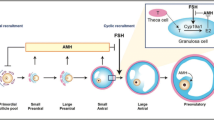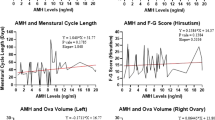Abstract
Purpose
Follistatin levels increase during the course of pregnancy and may play a role in ovarian arrest, reflected by the simultaneous decrease of anti-mullerian-hormone (AMH) levels. The aim of the study was to investigate AMH and follistatin levels during the hormonal window at the beginning of pregnancy. Since both parameters are described as deregulated in polycystic ovarian syndrome (PCOS), subgroup analysis of PCOS patients may additionally elucidate their interplay and effects on ovarian activity.
Methods
Serum samples were retrospectively analyzed using the AMH Gen II ELISA and the Human Follistatin Quantikine ELISA Kit. Samples were collected longitudinally from 57 patients (32 with PCOS and 25 controls) before conception and during the first trimester. In 18 patients, measurements from the early and the late first trimester were available. Potential associations of AMH and follistatin levels with PCOS-related parameters were compared between the subgroups as well as longitudinally before and in the first trimester of pregnancy. For statistical analysis, the Spearman’s correlation, Wilcoxon test, t test, Friedman test and multiple linear regression analysis was performed.
Results
In contrast to AMH, follistatin levels differed not between controls and PCOS patients before and in pregnancy. In both subgroups, AMH levels significantly decreased and follistatin levels significantly increased in longitudinally performed measurements before conceiving and in the first trimester of pregnancy.
Conclusion
Follistatin levels are not suited as a biomarker for PCOS, but could be involved in suppressing ovarian activity, as reflected by AMH levels at the beginning of pregnancy.






Similar content being viewed by others
References
Ueno N, Ling N, Ying SY, Esch F, Shimasaki S, Guillemin R (1987) Isolation and partial characterization of follistatin: a single-chain Mr 35,000 monomeric protein that inhibits the release of follicle-stimulating hormone. Proc Natl Acad Sci USA 84(23):8282–8286
Nakamura T, Takio K, Eto Y, Shibai H, Titani K, Sugino H (1990) Activin-binding protein from rat ovary is follistatin. Science 247(4944):836–838
Nakamura T, Hasegawa Y, Sugino K, Kogawa K, Titani K, Sugino H (1992) Follistatin inhibits activin-induced differentiation of rat follicular granulosa cells in vitro. Biochim Biophys Acta 1135(1):103–109
Xiao S, Farnworth PG, Findlay JK (1992) Interaction between activin and follicle-stimulating hormone-suppressing protein/follistatin in the regulation of basal inhibin production by cultured rat granulosa cells. Endocrinology 131(5):2365–2370
Findlay JK (1993) An update on the roles of inhibin, activin, and Follistatin as local regulators of folliculogenesis. Biol Reprod 48(1):15–23
Guo Q, Kumar TR, Woodruff T, Hadsell LA, DeMayo FJ, Matzuk MM (1998) Overexpression of mouse follistatin causes reproductive defects in transgenic mice. Mol Endocrinol 12(1):96–106
Cate RL, Mattaliano RJ, Hession C, Tizard R, Farber NM, Cheung A, Ninfa EG, Frey AZ, Gash DJ, Chow EP et al (1986) Isolation of the bovine and human genes for Müllerian inhibiting substance and expression of the human gene in animal cells. Cell 45(5):685–698
Weenen C, Laven JS, Von Bergh AR, Cranfield M, Groome NP, Visser JA et al (2004) Anti-Müllerian hormone expression pattern in the human ovary: potential implications for initial and cyclic follicle recruitment. Mol Hum Reprod 10(2):77–83
Durlinger AL, Visser JA, Themmen AP (2002) Regulation of ovarian function: the role of anti-Müllerian hormone. Reproduction 124(5):601–609
Matzuk MM, Finegold MJ, Mishina Y, Bradley A, Behringer RR (1995) Synergistic effects of inhibins and müllerian-inhibiting substance on testicular tumorigenesis. Mol Endocrinol 9(10):1337–1345
Köninger A, Kauth A, Schmidt B, Schmidt M, Yerlikaya G, Kasimir-Bauer S et al (2013) Anti-Mullerian-hormone levels during pregnancy and postpartum. Reprod Biol Endocrinol 11:60
Köninger A, Schmidt B, Mach P, Damaske D, Nießen S, Kimmig R et al (2015) Anti-Mullerian-Hormone during pregnancy and peripartum using the new Beckman Coulter AMH Gen II Assay. Reprod Biol Endocrinol 13:86
Köninger A, Schmidt B, Damaske D, Birdir C, Enekwe A, Kimmig R et al (2017) Follistatin during pregnancy and its potential role as an ovarian suppressing agent. Eur J Obstet Gynecol Reprod Biol 212:150–154
Wakatsuki M, Shintani Y, Abe M, Liu ZH, Shitsukawa K, Saito S (1996) Immunoradiometric assay for follistatin: serum immunoreactive follistatin levels in normal adults and pregnant women. J Clin Endocrinol Metab 81(2):630–634
Rae K, Hollebone K, Chetty V, Clausen D, McFarlane J (2007) Follistatin serum concentrations during full-term labour in women—significant differences between spontaneous and induced labour. Reproduction 134(5):705–711
Pigny P, Merlen E, Robert Y, Cortet-Rudelli C, Decanter C, Jonard S et al (2003) Elevated serum level of anti-mullerian hormone in patients with polycystic ovary syndrome: relationship to the ovarian follicle excess and to the follicular arrest. J Clin Endocrinol Metab 88(12):5957–5962
Köninger A, Koch L, Edimiris P, Enekwe A, Nagarajah J, Kasimir-Bauer S, Kimmig R, Strowitzki T, Schmidt B (2014) Anti-Mullerian Hormone: an indicator for the severity of polycystic ovarian syndrome. Arch Gynecol Obstet 290(5):1023–1030
Chen MJ, Han DS, Yang JH, Yang YS, Ho HN, Yang WS (2012) Myostatin and its association with abdominal obesity, androgen and follistatin levels in women with polycystic ovary syndrome. Hum Reprod 27(8):2476–2483
Teede H, Ng S, Hedger M, Moran L (2013) Follistatin and activins in polycystic ovary syndrome: relationship to metabolic and hormonal markers. Metabolism 62(10):1394–1400
Norman RJ, Milner CR, Groome NP, Robertson DM (2001) Circulating follistatin concentrations are higher and activin concentrations are lower in polycystic ovarian syndrome. Hum Reprod 16(4):668–672
Chen MJ, Chen HF, Chen SU, Ho HN, Yang YS, Yang WS (2009) The relationship between follistatin and chronic low-grade inflammation in women with polycystic ovary syndrome. Fertil Steril 92(6):2041–2044
Eldar-Geva T, Spitz IM, Groome NP, Margalioth EJ, Homburg R (2001) Follistatin and activin A serum concentrations in obese and non-obese patients with polycystic ovary syndrome. Hum Reprod 16(12):2552–2556
Fujiwara T, Sidis Y, Welt C, Lambert-Messerlian G, Fox J, Taylor A, Schneyer A (2001) Dynamics of inhibin subunit and follistatin mRNA during development of normal and polycystic ovary syndrome follicles. J Clin Endocrinol Metab 86(9):4206–4215
Erickson GF, Chung DG, Sit A, DePaolo LV, Shimasaki S, Ling N (1995) Follistatin concentrations in follicular fluid of normal and polycystic ovaries. Hum Reprod 10(8):2120–2124
Shimasaki S, Koga M, Buscaglia ML, Simmons DM, Bicsak TA, Ling N (1989) Follistatin gene expression in the ovary and extragonadal tissues. Mol Endocrinol 3(4):651–659
Keelan JA, Marvin KW, Sato TA, McCowan LM, Coleman M, Evans LW et al (1999) Concentrations of activin A, inhibin A and Follistatin in human amnion, choriodecidual and placental tissues at term and preterm. J Endocrinol 163(1):99–106
Hansen JS, Rutti S, Arous C, Clemmesen JO, Secher NH, Drescher A, Gonelle-Gispert C, Halban PA, Pedersen BK, Weigert C, Bouzakri K, Plomgaard P (2016) Circulating follistatin is liver-derived and regulated by the glucagon-to-insulin ratio. J Clin Endocrinol Metab 101(2):550–560
Wilson KM, Smith AI, Phillips DJ (2006) Stimulatory effects of lipopolysaccharide on endothelial cell activin and follistatin. Mol Cell Endocrinol 253(1–2):30–35
Keelan JA, Zhou RL, Evans LW, Groome NP, Mitchell MD (2000) Regulation of activin A, inhibin A, and follistatin production in human amnion and choriodecidual explants by inflammatory mediators. J Soc Gynecol Investig 7(5):291–296
Turcotte LM, DeFor TE, Newell LF, Cutler CS, Verneris MR, Wu J, Howard A, MacMillan ML, Antin JH, Vercellotti GM, Slungaard A, Blazar BR, Weisdorf DJ, Panoskaltsis-Mortari A, Holtan SG (2018) Donor and recipient plasma follistatin levels are associated with acute GvHD in Blood and Marrow Transplant Clinical Trials Network 0402. Bone Marrow Transplant 53(1):64–68
Rotterdam ESHRE/ASRM-Sponsored PCOS consensus workshop group (2004) Revised 2003 consensus on diagnostic criteria and long-term health risks related to polycystic ovary syndrome. Hum Reprod 19(1):41–47
Ferriman D, Gallwey JD (1961) Clinical assessment of body hair growth in women. J Clin Endocrinol Metab 21:1440–1447
Ludwig E (1977) Classification of the types of androgenetic alopecia (common baldness) occurring in the female sex. Br J Dermatol 9:7247–7254
Matthews DR, Hosker JP, Rudenski AS, Naylor BA, Treacher DF, Turner RC (1985) Homeostasis model assessment: insulin resistance and beta-cell function from fasting plasma glucose and insulin concentrations in man. Diabetologia 28:412–419
R Core Team. R: a language and environment for statistical computing. R Foundation for Statistical Computing, Vienna. ISBN 3-900051-07-0, URL: http://www.R-project.org/
Ying SY, Becker A, Swanson G, Tan P, Ling N, Esch F et al (1987) Follistatin specifically inhibits pituitary follicle stimulating hormone release in vitro. Biochem Biophys Res Commun 149(1):133–139
Shikone T, Matzuk MM, Perlas E, Finegold MJ, Lewis KA, Vale W, Bradley A, Hsueh AJ (1994) Characterization of gonadal sex cord-stromal tumor cell lines from inhibin-alpha and p53-deficient mice: the role of activin as an autocrine growth factor. Mol Endocrinol 8(8):983–995
Stanford JL, Hartge P, Brinton LA, Hoover RN, Brookmeyer R (1987) Factors influencing the age at natural menopause. J Chronic Dis 40(11):995–1002
Farahmand M, Tehrani FR, Pourrajabi L, Najafi M, Azizi F (2013) Factors associated with menopausal age in Iranian women: Tehran Lipid and Glucose Study. J Obstet Gynaecol Res 39(4):836–841
Li L, Wu J, Pu D, Zhao Y, Wan C, Sun L, Shen CE et al (2012) Factors associated with the age of natural menopause and menopausal symptoms in Chinese women. Maturitas 73(4):354–360
Parazzini F, Progetto Menopausa Italia Study Group (2007) Determinants of age at menopause in women attending menopause clinics in Italy. Maturitas 56(3):280–287
Yaden BC, Croy JE, Wang Y, Wilson JM, Datta-Mannan A, Shetler P, Milner A, Bryant HU, Andrews J, Dai G, Krishnan V (2014) Follistatin: a novel therapeutic for the improvement of muscle regeneration. J Pharmacol Exp Ther 349(2):355–371
Wang L, Qi H, Baker PN, Zhen Q, Zeng Q, Shi R, Tong C, Ge Q (2017) Altered circulating inflammatory cytokines are associated with anovulatory polycystic ovary syndrome (PCOS) women resistant to clomiphene citrate treatment. Med Sci Monit 23:1083–1089
Craig LB, Ke RW, Kutteh WH (2002) Increased prevalence of insulin resistance in women with a history of recurrent pregnancy loss. Fertil Steril 78(3):487–490
Chen MJ, Yang WS, Chen HF, Kuo JJ, Ho HN, Yang YS, Chen SU (2010) Increased follistatin levels after oral contraceptive treatment in obese and non-obese women with polycystic ovary syndrome. Hum Reprod 25(3):779–785
Dasgupta S, Pisapati S, Kudugunti N, Kathragadda A, Godi S, Reddy MB (2012) Does follistatin gene have any direct role in the manifestation of polycystic ovary syndrome in Indian women? J Postgrad Med 58:190–193
Urbanek M, Wu X, Vickery KR, Kao LC, Christenson LK, Schneyer A, Legro RS, Driscoll DA, Strauss JF 3rd, Dunaif A, Spielman RS (2000) Allelic variants of the follistatin gene in polycystic ovary syndrome. J Clin Endocrinol Metab 85(12):4455–4461
Acknowledgements
We thank the laboratory staff and the nurses of the University Hospital of Essen, Department of Gynecology and Obstetrics, for technical assistance and data documentation. We are grateful to Dr. Florence Witte for English editing and critical reading of the manuscript.
Funding
This study was funded by the University of Duisburg-Essen.
Author information
Authors and Affiliations
Contributions
A.Kö: project development, data collection, data analysis, manuscript writing; A.Ka: data collection, data analysis, biochemical analysis; PM: data analysis; BS: data analysis, manuscript editing; TS: data analysis, manuscript editing; RK: project development; AG: project development, manuscript writing.
Corresponding author
Ethics declarations
Conflict of interest
The authors declare that they have no conflict of interests.
Ethical approval
All procedures performed in this study involving human participants were in accordance with the ethical standards of the national research committee and with the 1964 Helsinki Declaration and its later amendments. The study was approved by the Research Ethics Committee of the Faculty of Medicine, University Duisburg-Essen, Germany (No. 11-4643).
Informed consent
Written informed consent was obtained from all individual participants included in the study.
Rights and permissions
About this article
Cite this article
Köninger, A., Kampmeier, A., Mach, P. et al. Tight interplay in early pregnancy between follistatin and anti-mullerian hormone in women with polycystic ovarian syndrome (PCOS). Arch Gynecol Obstet 297, 1307–1316 (2018). https://doi.org/10.1007/s00404-018-4718-4
Received:
Accepted:
Published:
Issue Date:
DOI: https://doi.org/10.1007/s00404-018-4718-4




